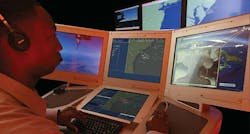Lockheed Martin to design combat management system shipboard electronics for Navy frigate
WASHINGTON, 23 Aug. 2016.shipboard electronics at Lockheed Martin Corp. will develop the combat management system for the U.S. Navy's future frigate surface warships under terms of a five-year $67.9 million contract announced Monday.
Officials of the Naval Sea Systems Command in Washington are asking the Lockheed Martin Mission Systems and Training segment in Moorestown, N.J., to develop the combat system for versions of the Navy littoral combat ship (LCS) that will be adapted to frigate use.
Frigates are relatively small, light, and fast surface warships that protect the powerful capital ships, and provide escort protection to lightly armed naval surface warships, as well as to commercial or military merchant ships.
Frigates play a crucial role of keeping naval battle groups together, intact, and functioning in the face of the enemy. They screen ships from aircraft and submarine attack, and can act as advance scouts to determine what's beyond the battle group's horizon.
Related: Navy looks to modified littoral combat ship design to serve as next-generation frigate
In addition to developing the combat management system for the Navy's future LCS-based frigate, Lockheed Martin also builds the Navy's Aegis combat system for Navy Arleigh Burke-class destroyers and Ticonderoga-class cruisers at its Moorestown, N.J. facility.
Lockheed Martin now builds the combat management system for the Navy's Freedom-class littoral combat ships. Independence-class littoral combat ships, meanwhile, use a combat system developed by Northrop Grumman Corp.
For the future frigate versions of the LCS, however, Lockheed Martin will base its new frigate combat management system on the company's COMBATSS-21 ship combat management system, which is aboard the Freedom-class littoral combat ships.
COMBATSS-21 is built on an open-architecture scalable framework using non-developmental software, Lockheed Martin officials say. Custom software adapters called boundary components support sensors, communications, and weapon interfaces, and are designed to accommodate future technology insertion and system upgrades with minimal effect on the system[s core software.
The COMBATSS-21 architectures isolates shipboard sensors, communication, and weapons from core components of the command and control system to avoid large system bugs and speed software certification.
COMBATSS-21 can run on computer configurations ranging from one commercial processor running a commercial operating system to more distributed configurations, to enable the COMBATSS-21 system adaptable to vessels ranging from patrol craft to large-deck ships, Lockheed Martin officials say.
The Lockheed Martin COMBATSS-21 combat management system borrows technology from Navy Aegis cruisers and destroyers, as well as the U.S. Coast Guard Deepwater program.
Related: Austal taking over U.S. Navy's Littoral Combat Ships business from General Dynamics
Monday's contract calls for Lockheed Martin to handle hardware and software development; software and hardware integration; and combat management system and combat system technical data packages for frigate versions of the littoral combat ship.
This contract has options that could increase its value to $79.6 million. Lockheed Martin will do the work in Moorestown, N.J.; San Diego; Clearwater, Fla.; and Manassas, Va., and should be finished by June 2021.
Learn more: search the Aerospace & Defense Buyer's Guide for companies, new products, press releases, and videos

